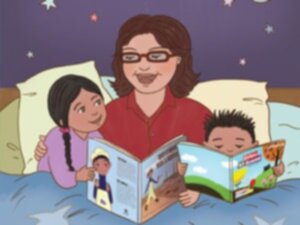
The Latino Family Literacy Project™ helps parents to establish a family reading routine, and to build strong Spanish and English skills.
An anti-bias preschool curriculum is one that seeks to acknowledge and challenge prejudices in education and works to remove them from the teaching and learning environment. Schools using an anti-bias curriculum are acknowledging that many Western societies, though growingly diverse, continue to function with inherent inequity and racial cultural bias, and that this naturally carries over into education, which is intrinsically a sociocultural institution. Louise Derman-Sparks and Julie Olsen Edwards, authors of Anti-bias Education for Young Children and Ourselves, write that “Inequity of resources in society, and the biases we use to justify that inequity, have an enormous impact on children’s lives. The dynamics of advantage and disadvantage, deeply rooted in our history, continue to shape the degree of access children have to education, medical care, security . . .”
Their work, at the forefront of anti-bias education, seeks to reduce cultural bias and misinformation in classrooms and to help children and the adults who work with them in schools to respect each other and to respect people in general.
Anti-bias education encourages educators to examine their own biases and cultural identities so that they may have strong self-awareness and also be aware of negative messages they may inadvertently be sending to students. This process allows teachers and other staff to model having a positive cultural self-image for students and encourages adults to begin to counteract their own biases in the classroom. Children can notice differences between people early on and will notice how adults treat others, so actively teaching them to respect all people is a powerful and important choice. One of the central ways that teachers put anti-bias curriculum to work in early childhood education settings is by exploring and honoring each person’s identity and fostering acceptance of diversity in the classroom and community.
Ellen Wolpert, long term preschool director and author of Redefining the Norm: Early Childhood Anti-Bias Strategies, shares this description of the anti-bias curriculum at work with young children:
“Children make comparisons among themselves, looking at the ways they are both similar and different. They learn that different is OK. This creates the foundation for respecting and valuing differences beyond their own families and communities.”
Children who share stereotypes and biases can be engaged in conversation about the bias and presented with visual and narrative examples that contradict the bias. The site, Teaching for Change, which focuses on social justice in education, shares a wealth of anti-bias articles with activity recommendations and professional development activities covering identity development, anti-bias curriculum, language development, and family resources.
The focus in an anti-bias program is on encouraging everyone in the educational community, young and old, to learn about and explore cultural identities and to get to know one another and the world around them with an open mind. Dr. Francis Aboud, who studied prejudice amongst youth, found that “after age 9, racial attitudes tend to stay constant unless the child experiences a life-changing event.” This trend underscores the importance of the implementation of preschool anti-bias curriculum and the promotion of tolerance.
Lectura Books is one of the leading publishers of multicultural and bilingual books, focusing on publishing for Parent Involvement with Latino parents and kids.
